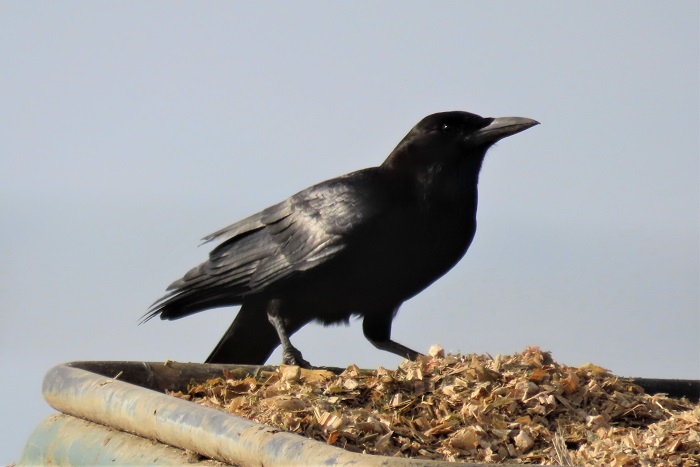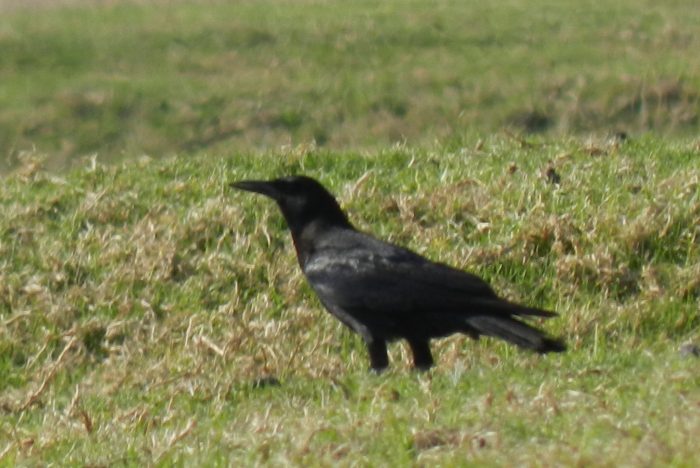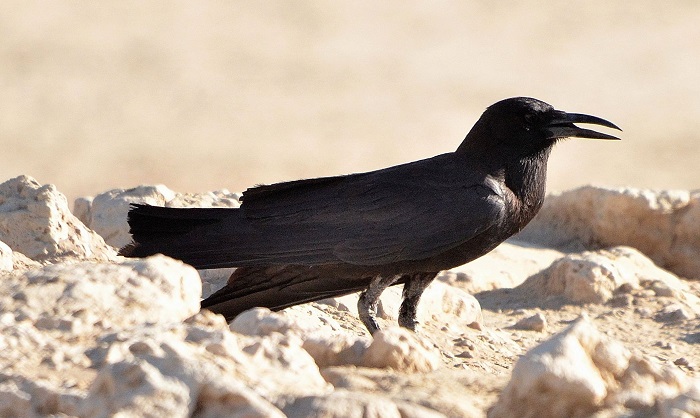Cover image of Cape Crow by Anne Todd – Kgalagadi Transfrontier Park, Northern Cape – BirdPix No. 270764
Identification
The Cape Crow is a distinctive black corvid. It is easily recognisable as the only all-black crow in the region. In both sexes the entire body is glossy black. The bill, legs and feet are also black. The head is rounded and the bill is pointed and more slender than in other corvids.
Juveniles are a duller brownish black.

Lotheni Nature Reserve, KwaZulu-Natal
Photo by Andrew Kruger
The Cape Crow is unlikely to be mistaken for any other species except the introduced House Crow (Corvus splendens), but that species has a dark greyish nape, mantle and breast. The House Crow is also smaller with a shorter, heavier bill.

Mackenzie Country Club, KwaZulu-Natal
Photo by Malcolm Robinson
Status and Distribution
The Cape Crow is generally a common species across its range. It occurs from Angola and Zambia Southwards, extending across southern Africa in a rather unusual distribution pattern. It is distributed almost continuously along the coast and adjacent interior from the Kunene River, through Cape Aghulhas to Richards Bay. An axis of distribution runs from the Etosha Pan in Namibia, through Botswana to Mpumalanga and western eSwatini (Swaziland). It It also ocurrs on the central plateau of Zimbabwe.
A second subspecies of the Cape Crow is found in nort-east Africa, centered on Ethiopia. The two subspecies do not overlap.

Details for map interpretation can be found here.
It is likely that the distribution of this adaptable species has been greatly influenced by human activities. Black Crows frequently build their nests on telephone poles and electricity pylons, and the erection of these structures has probably facilitated the spread of the Cape Crow into otherwise unsuitable, treeless areas. It is considered a pest by maize farmers.
Habitat
The Cape Crow is most common in open habitats with patches of trees or wooded watercourses. In the eastern regions of southern Africa it is generally a species of montane grasslands, and in the west of southern Africa it inhabits open, arid areas. It is uncommon in the Nama Karoo and in well-developed woodlands, but occurs in open, dry savannas, especially in the Kalahari. It is also common in cereal croplands where the natural vegetation has been removed for agriculture.

Near Estcourt, KwaZulu-Natal
Photo by Colin Summersgill
Behaviour
Cape Crows usually live as permanently territorial pairs but can occasionally be found in groups of up to 50 or more. They are less often solitary. The Cape Crow is a sedentary, resident species and is not known to undertake seasonal movements.

Near Estcourt, KwaZulu-Natal
Photo by Colin Summersgill
The Cape Crow is less aerial than other southern African corvids and spends much time perched or foraging on the ground.
Cape Crows are omnivorous. Insects are an important part of the Cape Crow’s diet, including a number of pest species suck as swarming locusts and the Karoo Caterpillar (Loxostege frustalis). Other insects taken include various beetles and their larvae, grasshoppers, termites etc. They also consume various arachnids, snails, lizards, frogs, young tortoises, and sometimes the chicks of domestic chickens

Midmar Nature Reserve, KwaZulu-Natal
Photo by Malcolm Robinson
The plant side of its diet consists mainly of bulbs, fruit and seeds, including fallen grain. They are fond of the fruits of the alien Prickly Pear (Opuntia ficus-indica) and are implicated in the dispersal of this pest in parts of the Karoo.
Cape Crows forage primarily on the ground, searching the bases of shrubs, grass and other low-growing vegetation. They regularly search for food along road verges and are partial to roadkill, although less so than the Pied Crow (Corvus albus). Cape Crows regularly follow ploughs to snap up any fleeing prey items and they are attracted to areas with livestock in order to probe around dung for insects and grubs. It is not known to attack young lambs in the manner of other, larger corvids. The Cape Crow is also less inclined to scavenge around human habitation than the Pied crow (Corvus albus), and is not often found in urban areas.

Near Wartburg, KwaZulu-Natal
Photo by Malcolm Robinson
Roosts in trees, either in pairs or family groups, and sometimes communally, forming large groups in trees. They roost on telephone poles and pylons in otherwise treeless desert and semi-desert regions. Cape Crows drink water regularly and are partial to bathing. Bathes by wading belly-deep in water and dipping the head and shaking the wings to wet the entire body.
Cape Crows are recorded breeding from July to January, although most breeding takes place from September to November. The nest is a bulky cup-like structure made from plant stems and leaves. The nest is is a large bowl of sticks, twigs and sometimes bits of wire. it is thickly lined with wool, fur, cloth, string, feathers and dry dung. The nest us usually placed among thin branches near the top of a tall tree or at the top of a telephone pole.

Near Underberg, KwaZulu-Natal
Photo by Pamela Kleiman
Anywhere from one to six (usually four) eggs are laid per clutch. The eggs are pale pink with brown to purplish spots and speckles. Incubation takes 18 or 19 days and duties are shared by both sexes. The nestling period lasts 36 to 39 days and the young are also fed by both parents. Fledged birds are dependent on their parents for food for up to three months after leaving the nest and may remain with the parents for up to six months.

Between Calvinia and Williston, Northern Cape
Photo by Amour McCarthy
Further Resources
Species text in first Southern African Bird Atlas Project (SABAP1), 1997.
The use of photographs by Amour McCarthy, Andrew Kruger, Anne Todd, Colin Summersgill, Malcolm Robinson and Pamela Kleiman is acknowledged.
Virtual Museum (BirdPix > Search VM > By Scientific or Common Name).
Other common names: Black Crow (Alternative English); Swartkraai (Afrikaans); iNgwababane (Zulu); Unomyayi (Xhosa); Corbeau du Cap, Corneille du Cap (French); Kapkrähe (German); Kaapse Roek (Dutch); Gralha do Cabo (Portuguese)
Recommended citation format: Tippett RM 2024. Cape Crow Corvus capensis. Biodiversity and Development Institute. Available online at https://thebdi.org/2024/01/10/cape-crow-corvus-capensis/
List of bird species in this format is available here.

Near Uniondale, Western Cape
Photo by Cobus Elstadt

